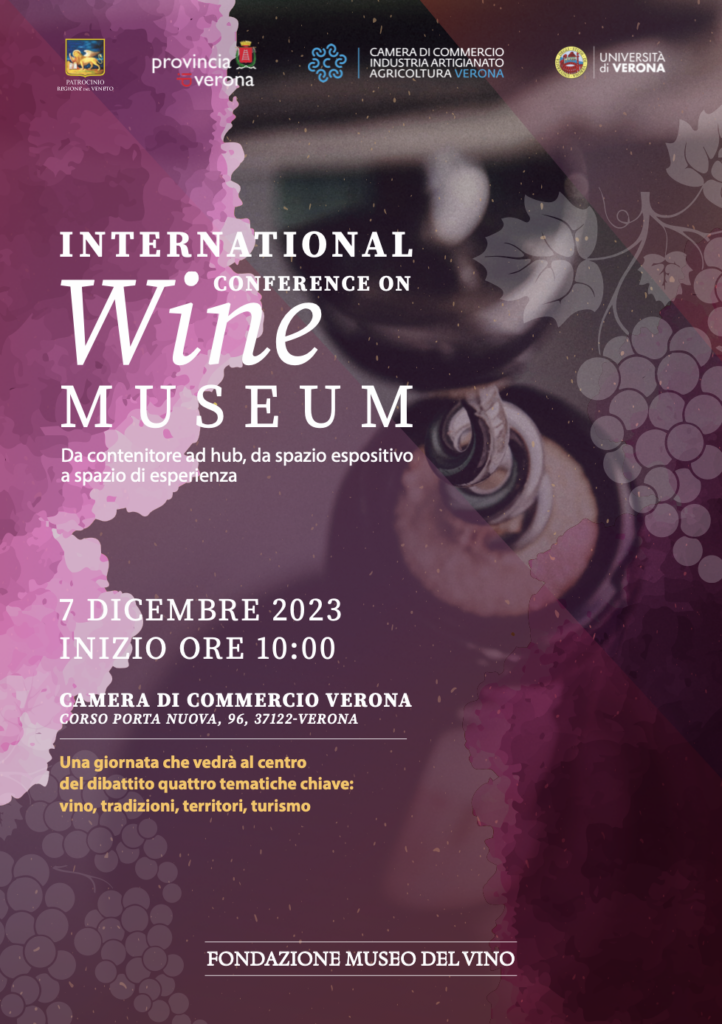A turning point for wine museums: from museum spaces to experience hubs, following the example of European excellence
One year after its establishment, the Wine Museum Foundation MUVIN organized, on the 7th of December, an internationally significant event in Verona at the Chamber of Commerce. The event aimed to discuss and network knowledge, experiences, best practices, and projects related to the current role, innovations, and future challenges of European wine museums. Several of the most important national and international entities participated, including La Cité des Climats et des Vins de Bourgogne and La Cité du Vin in Bordeaux (France), the Vivanco Museum of Wine Culture (Spain), and World of Wine – WOW (Portugal). Italian participants included the Piedmontese Wine Cellar Castello Grinzane Cavour, the Archaeological Park of the Colosseum, MUVIT – Wine Museum of Torgiano, and the Wine Museum of Berchidda. Wine, traditions, territories, and tourism were the four main themes addressed by the fourteen speakers, moderated by journalist Angela Frenda. They tackled various perspectives on organization and management, services and experiences for education, heritage exhibition with a focus on new technologies, marketing strategies to effectively position themselves in the market, and museum sustainability towards the territory. “With this inaugural scientific event,” said Diego Begalli, President of the MUVIN Wine Museum Foundation, “the Wine Museum Foundation positions itself at the center of the international debate on promoting wine culture through museum activities. The simultaneous presence in Verona of such important national and European testimonies confirms Verona as a national reference hub in this sector, synergistically fueling its positioning through participation in the Great Wine Capitals Network.” “In Italy, there are 46 wine museums and 83 taste museums, a number higher than other countries such as France and Spain,” said Roberta Garibaldi, President of the Foundation’s Scientific Committee. “However, they are often small and medium-sized entities, mainly owned by municipalities (41% of wine museums and 52% of taste museums) or companies (33% and 24%). This plurality well represents and testifies to the richness of Italian food and wine, which boasts the highest number of certified productions in Europe, revealing aspects that can be enhanced through network collaboration. The project initiated in France, where the Ministry of Culture has recently favored the creation of a European network of Wine Museums, labeled by Iter Vitis, serves as a model, the REMCI VITIS NETWORK, a net of wine museum started in France but now open to the whole European already includes la Cité du Vin de Bordeaux and la Cité des Climats et des vins de Bourgogne .
From showcases of heritage to multi-functional spaces while the conservation and protection of oenological heritage remain central to the mission of Wine Museums, these functions are no longer exclusive today. These entities are now tasked with making this important heritage accessible, engaging and educating visitors, and connecting the museum with rural areas. The conference highlighted how traditional tour paths are evolving into immersive and experiential tours thanks to the use of new technologies and sensory activities. In Spain, there are gaming and escape room proposals like Giant Interactive Maps winner of the Iter Vitis award for technology in 2023. The wine experience is enriched with various facets: Vivanco focuses on the combination of art and wine, displaying masterpieces of contemporary modern art from Chagal to Warhol; World of Wine – WOW emphasizes variety with the Chocolate Story Museum and the Pink Palace, which appeals to younger audiences with its Instagrammable features. In Italy, Castello di Grinzane has created a museum path in the vineyards, while the Archaeological Park of the Colosseum (also member of Iter Vitis) offers a unique scenario where viticulture merges with archaeology. Wine Museums are becoming gastronomic hubs, connecting with wine territories. .
In the near future, the role of Wine Museums will be to promote the socioeconomic development of territories through the tourist enhancement of wine culture, strengthening connections with rural areas. This complex challenge requires these entities to work towards increasing their attractiveness to a diverse audience with different needs and collaborate with territories, companies, and other museums to find common solutions.

